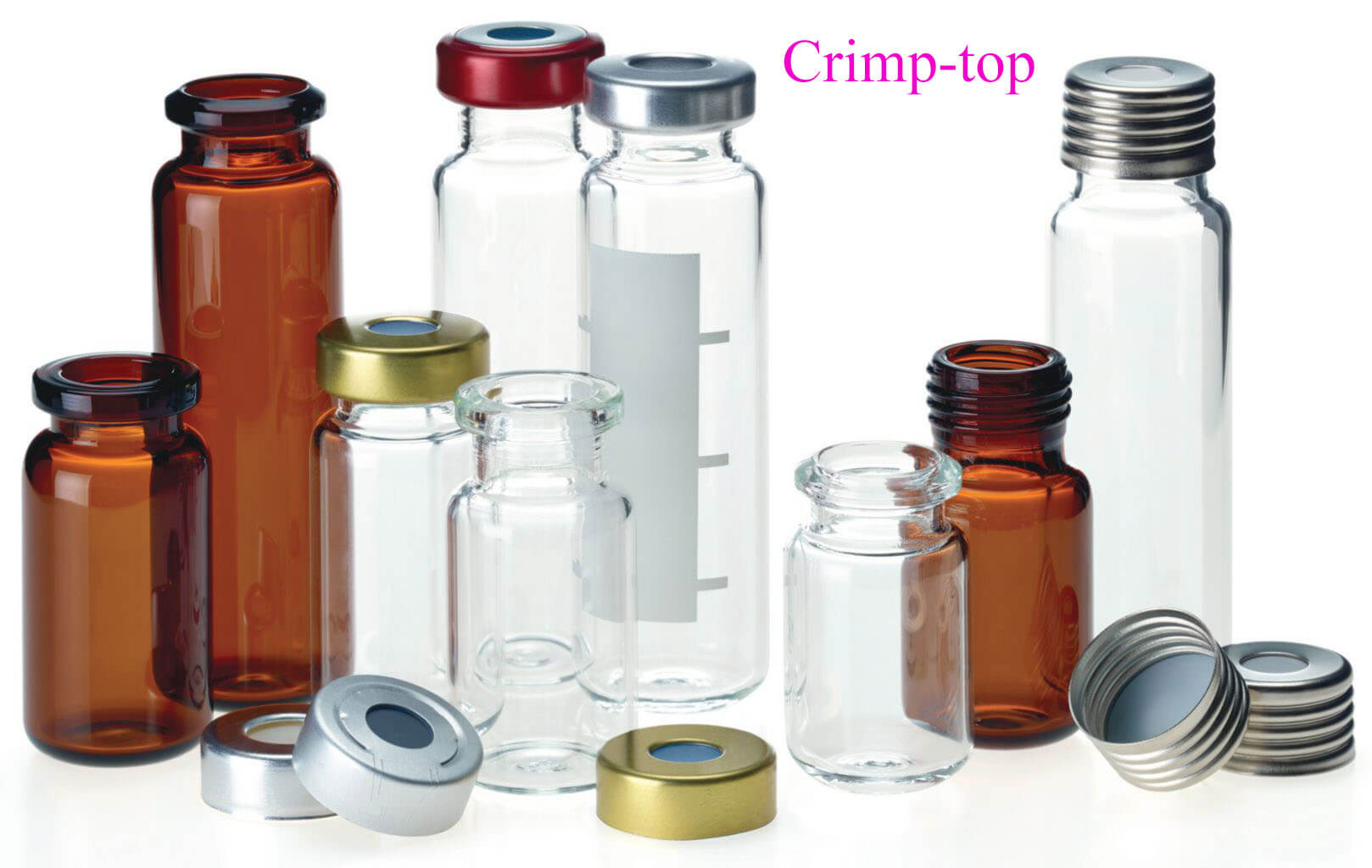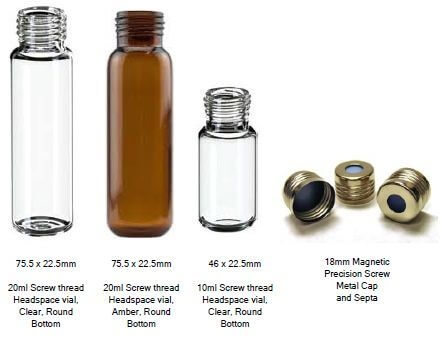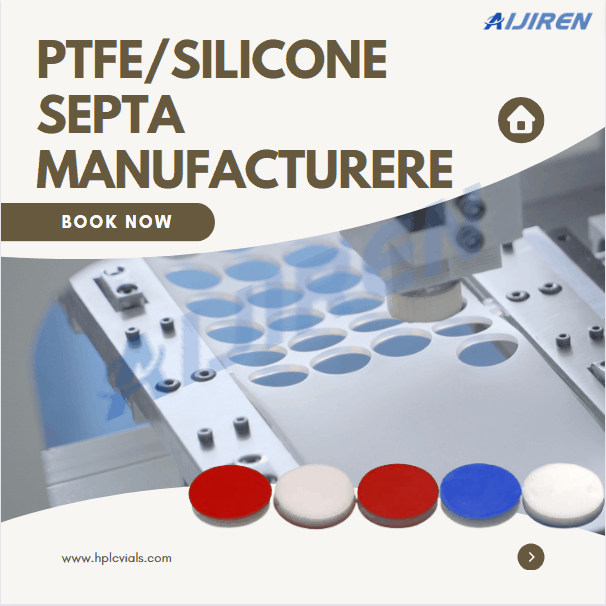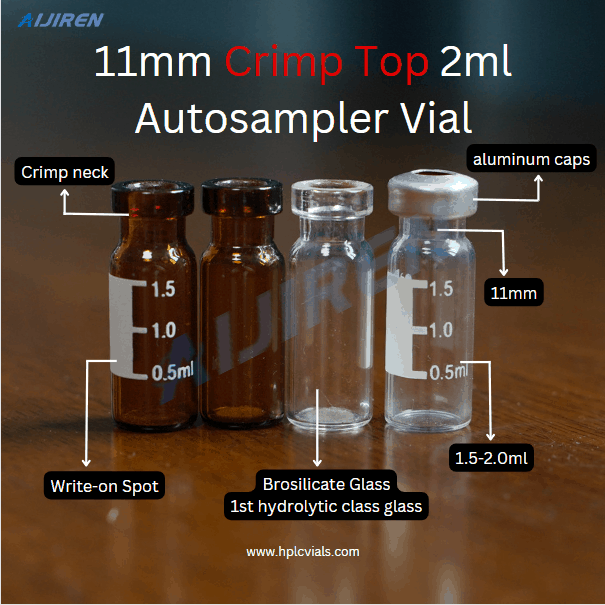What is a Headspace Vial?
The brief introduction of headspace vials
Headspace vials are one of those rare laboratory supplies that are appropriately named: headspace vials are lab vials with extra space at their top (head). Simple! They’re typically used in autosampler machines in chromatography, and for that reason are sometimes called autosampler vials or chromatography vials.
Headspace vials are available in two major styles: crimp top and screw thread. Crimp top vials have a metal cap that’s closed with a handheld crimper. Neat. Screw thread vials have a simple screw cap, just like that cheap wine you keep buying. Both types employ stoppers or septa between the cap and the vial, depending on the application.

Why choose headspace vials?
High-Quality headspace vials with a beveled neck for a secure seal, uniform glass thickness for even heat distribution, and a stable, strong design for ease of use. Available with rounded or flat bottom profiles for accurate instrument compatibility. Use 20mm headspace caps and septa and seal with 20mm crimping accessories.
What types of headspace vials?
Round bottom or flat bottom
Choosing a headspace vial with a flat (also called a square) bottom or round bottom depends on your particular instrument. Generally, round-bottomed vials are used for robotic arm autosamplers that will pick up a vial and bring it to the autosampler needle, while flat-bottomed vials are used for autosamplers that bring the needle to the vial. A round bottom vial is self-aligning when it’s returned to the vial rack by the robotic arm, while a flat-bottomed vial is slightly more stable while it’s in the rack. It is best to check your autosampler’s user manual if you are not sure.
Beveled or flat top
Flat-topped vials can be used with almost any headspace autosampler. Beveled top vials can be used with some autosamplers. As usual, the best way to be sure which to choose is to check your autosampler’s manual. A quick guideline is that autosamplers that don’t move the vial out of the rack can use beveled top vials. Robotic arm autosamplers that use a magnetic pick-up must use flat-top vials (to give adequate contact between the magnet and the cap). Other robotic arm autosamplers may or may not be able to use beveled top vials, depending on how they grip the vial. Beveled top vials can improve the seal formed by the crimp top. In a flat-topped vial, the sealing pressure is primarily at the outer rim of the vial, cap, and septum. With a beveled top vial, the sealing pressure is evenly distributed across the top of the vial, improving the seal.
Screw-top or crimp-top


Screw caps for headspace vials are a recent development, originally intended for magnetic robotic arm autosamplers. They sidestep the problem of crimping on an all-steel cap or a composite steel/aluminum cap. The plated steel caps are reusable and do not require tools to seal or open vials. They have some drawbacks too. They can only be used for 10mL and 20mL vials. Too much of the internal volume of a 6mL vial is lost to the threaded neck for the cap. Screw cap headspace vials are not suitable for use with mechanical robotic arm autosamplers. The neck of a screw thread vial is a different diameter than that of a crimp top vial, and the screw cap vial lacks the natural ledge formed by the lip of a crimp top vial. That ledge is frequently used by the autosampler to help align and lift the vial.
What are the basic principles of headspace analysis?
A headspace sample is usually prepared in a vial containing the sample, the dilution solvent, a matrix modifier, and the headspace. Volatile components from complex sample mixtures can be extracted from non-volatile sample components and isolated in the headspace or gas portion of a sample vial. A sample of the gas in the headspace is injected into a GC system for the separation of all of the volatile components. In order to achieve the best performance with headspace GC, careful attention should be paid to sample preparation and instrument setup. The vial and cap are very important, and often overlooked, elements in the headspace analysis preparation.
It is important to ensure the correct vial and cap are used!
Vial Size
Headspace vials are available in 6, 10, and 20 ml sizes. Use a vial large enough to ensure adequate headspace or phase ratio without excessive dilution of the components of interest. The phase ratio is discussed later and should normally be at least 50 % of the sample volume.
Bottom Profile
Headspace vials may be round-bottomed or flat-bottomed. Either type is suitable but round-bottomed vials tend to be stronger and may work more reliably when the autosampler moves the vials into and out of the incubator. Round-bottomed vials also tend to withstand higher pressures and are more suitable for elevated temperatures and applications such as derivatization.
Correct Crimping
Headspace vials must be correctly crimped. Ensure the crimper is not worn and is adjusted correctly. The cap should not turn after application to the vial. Find out more about correct vial crimping.
Septa Choice

Use septa suitable for the temperature of the system. Poor septa Poor septa can result in bleed and so contaminate the headspace.
Cleanliness of Vial
Vials should be clean. Not all vials are the same and dirty or re-washed vials can cause ghost peaks or erroneous results.
Conclusion
At Growing Labs, we don’t sell name-brand headspace vials. Small and medium labs don’t have the budget to waste on vanity name brands; they buy acetaminophen, not Tylenol because it’s the same thing – except much cheaper. That’s one of our specialties: offering equivalent alternatives so that our customers can save on budget. So if you are interested in headspace vials and want to know more details about them, welcome to the Web.
Back to List
-
 下午4:09Weighing the Pros and Cons of PTFE/Silicone Septa
下午4:09Weighing the Pros and Cons of PTFE/Silicone Septa -
 下午4:05Decoding Vial Discard Guidelines: Ensuring Precision in Chromatography
下午4:05Decoding Vial Discard Guidelines: Ensuring Precision in Chromatography -
 下午5:01Navigating Micro Inserts for HPLC Vials: A Comprehensive Guide
下午5:01Navigating Micro Inserts for HPLC Vials: A Comprehensive Guide -
.jpg) 下午2:02Common faults and solutions of automatic samplers(2)
下午2:02Common faults and solutions of automatic samplers(2) -
 下午5:08Ensuring Sample Integrity: Navigating EPA Storage Vials Stability Guidelines
下午5:08Ensuring Sample Integrity: Navigating EPA Storage Vials Stability Guidelines

